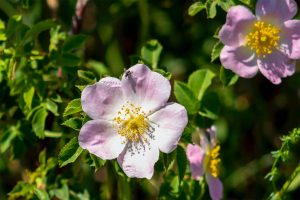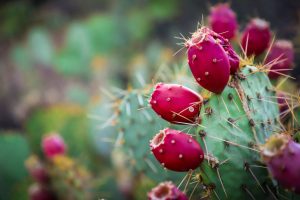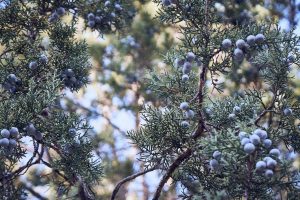Even though we’re heading into what is undoubtedly another cold winter here in Colorado, there’s no reason to shelf all of your landscaping plans until spring. While most plants go dormant throughout the colder months of the year, there are several plants that are well-suited to dealing with Colorado’s winter climate. Some will even allow you to stand out amidst a sea of brown, dormant lawns and landscapes with bright colors, while others may attract birds and other wildlife onto your property with fruits or foliage.
Here are just a few of Colorado’s winter-friendly native plants that you can incorporate into your commercial landscaping:
7 Winter Friendly Plants for Colorado Landscapes
-

Rose Plants
While many people associate roses with spring and summer, certain types of roses can handle Colorado’s winters quite well. Colorado has three native wild roses – mountain rose (Rosa woodsii), prairie rose (Rosa arkansana), and prickly rose (Rosa acicularis). There are also a handful of non-native roses that are well-suited for harsh winters. Although roses don’t typically bloom during winter, many birds and small mammals use their fruit (rose hips) as winter food. The keys to keeping roses healthy during winter are:
- Choose native Colorado roses or other winter-friendly varieties
- Fertilize roses in September to help them prepare for winter
- Apply mulch to help insulate the soil temperature and moisture
Holly Plants
Colorado is home to two native hollies: the creeping Mahonia holly (Mahonia repens, aka creeping grape) and the Oregon grape holly (Mahonia aquifolium). Creeping grape holly typically grows between 6-15 inches tall, making it a great groundcover plant. Oregon grape holly grows much taller, anywhere from 3-6 feet. In winter, both plants’ shiny green foliage turns a deep burgundy, which can add a great splash of color to an otherwise dormant landscape. Both native hollies require little water and maintenance, and can also tolerate full sun.
-

Prickly Pear
There are several winter-friendly cacti in Colorado, but prickly pear (Opuntia) is arguably the most popular choice for landscaping. During the winter prickly pear will change color as it becomes less active; red, orange, and yellow pads are common to see. However, in the summer it comes alive with bright yellow, pink, or even violet flowers. Prickly pear is known for its edible fruit, which is juicy and sweet. Both the flowers and fruit are great attractors for birds, pollinators, and other wildlife. Prickly pear is a natural choice for low-water landscaping and xeriscaping in Colorado because it thrives during hot, dry summers and can tolerate harsh winters.
Rabbitbrush
Rabbitbrush is one of the most popular native plants used in Colorado landscapes. There are two main types of Rabbitbrush in Colorado: Rubber Rabbitbrush (Ericameria nauseosa) and Sticky Rabbitbrush (Chrysothamnus viscidiflorus). Rabbitbrush is a globe-shaped shrub that grows anywhere from 2-4 feet tall and 2-6 feet wide. It is covered with small silvery leaves and fluffy seed clusters in the winter, which turn to large clusters of yellow flowers in the summer. Rabbitbrush is an extremely hardy plant, with deep root systems that help it thrive in dry climates. It also thrives in full sun and is well-accustomed to local soil conditions.
-

Red Twig Dogwood
Red twig dogwood is one of the most visually-striking plants native to Colorado. Like its name promises, red twig dogwood (Cornus sericea) has bright red branches that can really make a landscape stand out during the winter months. During the warmer months, it has clusters of small white flowers that give way to white berries in the late summer, which are great bird attractors. Red twig dogwood can grow to be quite large, averaging anywhere from 6-8 feet tall and 8-12 feet wide. Although it can handle winters in Colorado quite well, red twig dogwood requires regular watering during the growing season to really thrive.
Colorado Blue Spruce
The official state tree of Colorado, the Colorado Blue Spruce (Picea pungens) is found all over the state, and is a tried-and-true choice for landscaping. The quintessential Christmas tree, the Colorado Blue Spruce generally grows anywhere from 30-60 feet tall (sometimes up to 75 feet in the wild!) and can stretch out to 15-20 feet at its widest. Colorado Blue Spruce is renowned for its silvery-blue foliage, which is commonly used in holiday decorations. It is relatively low-maintenance, can be planted in full sun, and is fairly drought-resistant.
-

Rocky Mountain Juniper
There are three kinds of juniper native to Colorado, but the one most commonly found along the eastern foothills and Front Range is the Rocky Mountain Juniper (Juniperus scopulorum). Rocky Mountain Juniper can grow anywhere from 20-30 feet tall, with an average width of 8-15 feet. Its foliage can range in color from a dark green to a blue-green, and birds and other animals love its small, light blue berries, especially during winter. Rocky mountain Juniper is the most cold-tolerant of all junipers, prefers full sun, and is very drought-resistant.
Create or Maintain A Beautiful Winter Landscape with GroundMasters Landscape Services
Our team at GroundMasters Landscape Services has the expertise you need to transform your commercial property into a winter wonderland and keep it well-maintained no matter the season. Our year-round services include lawn care, sprinkler system maintenance, tree & shrub care, and landscape enhancements – along with storm cleanup and snow & ice removal for when bad weather hits.
To see what GroundMasters can do for your Denver-area business or commercial property, give us a call at (303) 750-8867 or get in touch with us online to get started.
